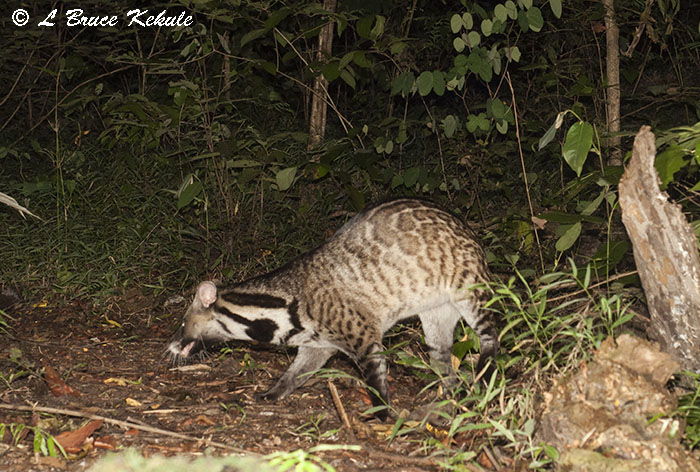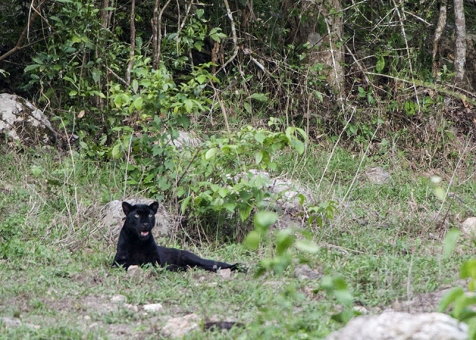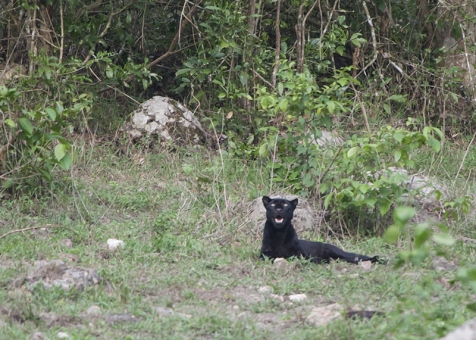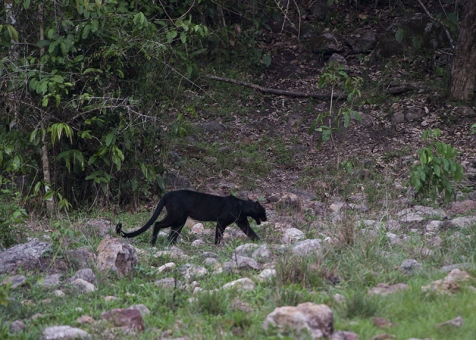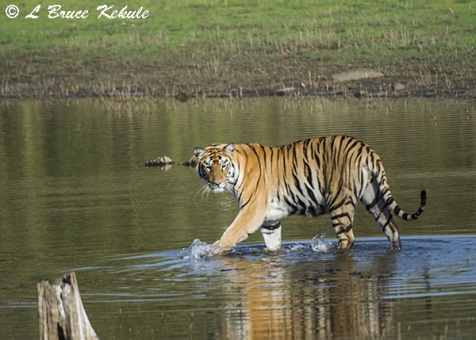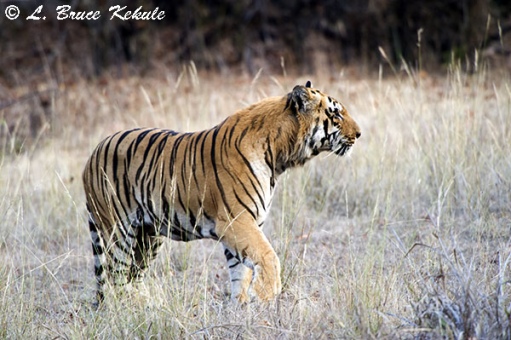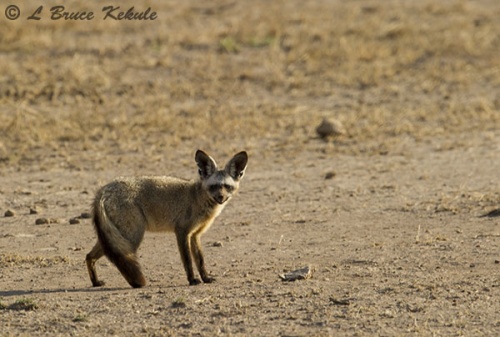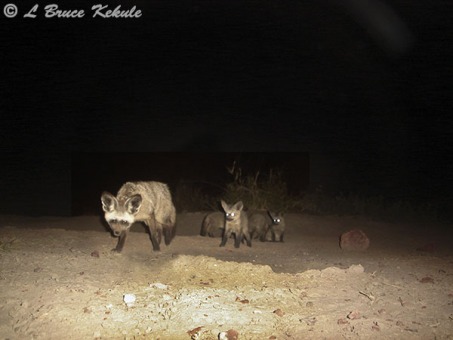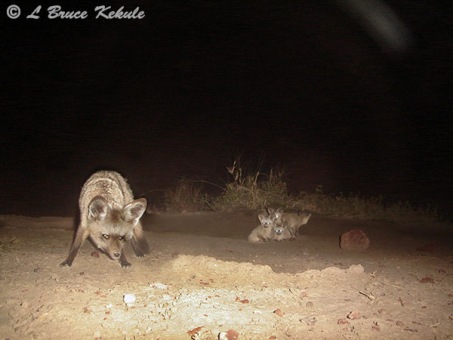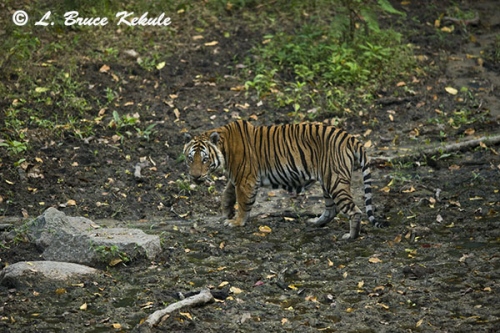Posts Tagged ‘carnivore’
Nikon D90 DSLR trail cam catches a ‘Large Indian Civet’
The ‘Big Cat Trailhead’ has proven to be a real wildlife haven with loads of cats plus other carnivores walking past on almost a daily/nightly basis. Because of so much interaction, I decided to set-up my Nikon D90/SB400/Yeti/Plano 1460 case facing the other way opposite my Canon 400D.
The Yeti board was very old and not working too well. I tried to adjust distance and sensitivity but it still would only trip the cam from about a meter away. However, the cam did get one shot of a ‘Large Indian Civet’ shown here. The markings on this medium sized carnivore are unique and these creatures are very common in this forest.
I have since brought the cam home and replaced the board with a Snapshotsniper SSII #5 board and it is now ‘rocking and rolling’. Look forward to checking both cams in a couple of weeks and I’m confident there will be some interesting creatures walking past…! Enjoy.
Canon 400D DSLR catches a ‘black leopard’
Once again, the ‘Big Cat Trailhead’ situated deep in the Western Forest Complex continues to be a real hotspot for the big cats. Both black and yellow phase leopards were captured on digital stills and video at this location.
In July at the beginning of the rainy season, I set my Canon 400D down low (about two feet off the ground) on a tree at the trailhead wanting a real low-down set-up. When I returned, the lens was completely covered by sand and mud from extremely heavy rain and splatter…and no photos were on the card: a disappointment…! I then moved the cam way up about five foot and angled down about 45 degrees.
After some three weeks, I was back and a black leopard had passed the cam at night. Only one flash went off (a Nikon SB-28) and just one good shot was acquired. A bunch more were captured of the cat but it was standing half-out of the frame. The Canon flashes (270EX) have proven to not be very reliable and I will probably just drop them out eventually. The Nikon flashes (especially the SB-28s) are better and last longer on stand-by.
Even though the composition is not the greatest, it’s still a good record shot…I have since moved the cam back down to about three feet hopefully to catch a full-frame head-on shot of this melinestic creature. I have now caught this cat 5-6 times including a beautiful daytime video as the black cat passes by and another IR video showing its spots…I will be posting these vids soon.. Enjoy..!
A Black Leopard in Broad Daylight
A rare encounter: A black cat appears deep in the interior of the Western Forest Complex
My first black leopard in the late afternoon sun showing its spots some 15 years ago.
It is late April in the forests of the Western Forest Complex, one of my favorite places in Thailand. The first rains have come and doused the dangerous forest fires that spread throughout the area during the dry hot season starting in March and ending in May.
As usual, I’m setting-up camera traps at a hot-springs (mineral deposit) not far from a ranger station some 50 kilometers deep in the interior accessible only by a dirt road.
This natural seep is visited by all the large mammals including tiger, leopard, elephants, gaur, banteng, tapir, sambar and many other smaller creatures, and provides excellent opportunities for some great animal shots.
As I was going through a few of my camera traps changing out cards and batteries, I decided to have a quick look at a 2GB card that was in one of my cams.
A black leopard in mid-afternoon camera trapped on a trail to the hotspring.
Imagine my surprise to see a shot of a ‘black leopard’ in mid-afternoon walking up a trail shown in the story. Other denizens caught in this series include elephant, tapir, sambar, wild pig and muntjac (barking deer) over a month period back in February of this year. The leopard was truly a bonus and I had actually closed out the program with this cam.
This black leopard brought back fond memories of this place more than 15 years ago. I was sitting in a tree blind up by the hot springs when a black leopard walked out into the open about 4pm and posed for me at several places for over the next hour.
Those were in the old days of slide film, and I did not know how good the shots were until the film was processed. A few images are shown here from that lucky sequence many years ago. The sun was low and the black leopard showing its spots is one of my best wildlife photographs ever.
Posing on a fallen tree at the beginning of my career of wildlife photography.
Sometimes things happen in succession that boggles the mind. On May 6th, I posted the ‘black leopard’ camera trap image on my website. The next day I left Bangkok very early in the morning and arrived at the hot springs. I was back to reset camera traps, and this time to sit at the base of the old tree for some through-the-lens work. Who knows what might show-up.
Resting in the late afternoon and scoping out the area for prey, May 2013.
This black cat stayed for about 10 minutes.
A rare carnivore still surviving in Thailand.
Another once in a lifetime encounter as it leaves the mineral deposit.
I was with my good friend Sarawut Sawkhamkhet, a Thai wildlife photographer. We arrived and set-up a temporary blind about 3pm. The weather was warm and balmy with nice clear-blue skies.
At 5:45pm, the unthinkable happened! A ‘black leopard’ appeared out of the forest near the springs and walked over for a drink, and then disappeared for a short while. Then this magnificent creature came back and flopped down on all fours twitching its tail looking straight at us and staying for about 10 minutes before going back in the forest where it had come from.
The leopard (Panthera pardus) described by Linnaeus in 1758 is the second largest cat in Thailand. Once upon a time, leopards could be found in most forests of the Kingdom. These felines are still surviving quite well in protected areas in the West, and many forests in the South. The central, eastern and northeastern regions have no reports of leopard for long time now.
Pound for pound, the leopard can take on some seriously large animals several times its size. The leopard is closely related to the jaguar of South America. Both have a spotted coat pattern and incidence of ‘melanism’ or black phase. Many people have a misconception about the black leopard (also known as the black panther) as a separate species but in fact, it is the same as the yellow phased leopard.
The present distribution of the leopard is restricted to Asia Minor, India, Southeast Asia, the Himalayas, Tibet, China, Siberia, and Africa. Fossils of leopards have been found in Pleistocene deposits throughout Europe, the Middle East, Java, and Africa, some 1.5 million years old, indicating the leopard arrived after the tiger which has been around for about two million years.
These secretive cats are mainly nocturnal but in some localities, they are active in the day too. Their populations and ranges are difficult to determine but radio tracking of collared animals has shed new light on their movements and areas they live in.
Sighting a leopard in Asia is extremely difficult, and even catching a rare glimpse of this very essential top predator is tough due to its solitary and stealthy behavior. However, luck can sometimes play an important part in viewing the leopard and I feel lucky to have seen and photographed them on quite a few occasions.
My most thrilling or heart stopping adventure with a black leopard happened in Huai Kha Khaeng about five years ago while I was sitting up on a bluff overlooking the river. A photographic blind was erected on the rock-face about 20 meters up with a small trail that enabled me to get into the hide. The sun was bright and the weather was warm during the dry season.
About 9am, several monks down by the river passed on but did not see the camouflaged structure as they went their way. After that, I came down for lunch and set some camera traps at a mineral deposit nearby. At 2pm, I settled back in the blind and began a vigil of the river. I started to feel a bit groggy as the sun was beating down on my position. I moved my camera in to save it from the direct sunlight.
All of a sudden, I was startled by a guttural growl outside the enclosure. I stood up peering out the window and came face to face with a huge round black head and yellow eyes about two meters away that penetrated my soul. My first instinct reaction; it was a big black dog. But that quickly changed as the creature stared intently at me before bounding down the trail it had come up. The big cat was gone in a split second. Of course there was not enough time to get any photographs. The incident surely is etched in my memory.
Without doubt, the future of the leopard depends on one thing only – the complete protection of the remaining forests where they live. If the national parks and wildlife sanctuaries remain intact with a high number of prey species, the big cats will survive. But if over-development, poaching and encroachment are allowed to continue, the large cats will eventually disappear.
Unfortunately, too much time and money is wasted by too many organizations talking about saving wildlife and their habitats, with very little actually being done. Human population growth will eventually destroy most wild places. Only true protection by some dedicated people will slow the destruction of nature’s precious wildlife and wilderness areas. It is hoped the leopard, and the tiger, will continue to survive as they have for millions of years.
A ‘Black Leopard’ again..!
An extraordinary sighting in Huai Kha Khaeng Wildlife Sanctuary
A black leopard resting at the hot spring.
Sometimes things happen in succession that boggles the mind. On May 6th I posted a tale about a ‘black leopard’ plus other Asian wild animals caught by my Sony S600 cam on a trail into a hot spring in Huai Kha Khaeng Wildlife Sanctuary, western Thailand where I’m currently running a camera trap program.
Entering the hot spring.
I also mentioned in the story that I photographed a ‘black leopard’ from a tree blind some 15 years ago just up the trail a bit. The ‘leopard spots’ image is one of my all-time favorite wildlife photographs ever. http://brucekekule.com/camera_trapping/a-black-leopard-passes-my-camera-trap/
Leaving the hot spring.
On May 7th, I was back at the hot springs to set camera traps, and to sit at the base of the old tree for some through-the-lens work. Who knows what might show-up.
I was with my friend Sarawut Sawkhamkhet, a Thai wildlife photographer. We arrived and set-up a temporary blind about 3pm. The weather was warm and balmy with nice clear-blue skies.
A full-frame shot.
At 5:45pm, the unthinkable happened! A ‘black leopard’ appeared out of the forest near the springs and walked over for a drink, and then disappeared for a short while. Then the magnificent creature came back and flopped down on all fours twitching its tail looking straight at us staying for about 10 minutes before going back in the forest where it had come from.
Kabook Kabieng hot springs deep in the interior.
I would venture to say, this is the same cat I camera trapped back in February and it could also be an offspring of my original leopard back in 1998. Who knows? I was elated to say the least.
To see and photograph a black leopard once again at this same location after all these years is something out of the extraordinary. When time permitted, I set one of my trusty Sony S600 cams at the hot spring and will go back in a couple of weeks to see what has visited the waterhole.
Then I intend to set a DSLR Nikon or Canon camera trap with several flashes for improved images. This place is truly worth the effort, time and difficulty to get here. I look forward to more incredible images from this wildlife haven.
The tigers of Tadoba
India: Land of the tiger
Two tiger cubs sparring in the lake at Tadoba.
After 10 amazing days in the sub-continent of India, I returned to Thailand with a load of tiger photographs. A few shots are some of my best work as a wildlife photographer shown here. The opportunity to see and catch this illusive carnivore presented itself. However, some parts of the trip were extremely dangerous and stressful including a nine-hour taxi ride to and from Tadoba Tiger Reserve in the State of Maharashtra some 700 kilometers north from Hyderabad. It was hectic to say the least.
Only 20% of the sanctuary is now open with 80% off-limits but it is truly India’s top protected area for tiger sightings. I saw nine tigers in seven days. It was very exciting seeing and photographing the big cat. This is just part of the selection of shots I got. It shows a truly magnificent ecosystem where predators thrive because prey species are found in abundance. I will be doing an extensive post a little bit later.
The same pair facing-off.
Tiger cub in the lake.
Tiger male walking by the lake.
Tiger female by the lake.
Tiger cub about three meters away.
Old ‘One Eye’, father of the cubs near the road.
Tiger cub posing by side of the road
Tiger cub about to yawn
Tiger cub showing its fangs
Needless to say, it was an experience now etched in memory. All shots were taken with a Nikon D3s and 200-400mm VRII lens and mono-pod except for the tiger close-up, and that was with a Nikon D90 and a 70-300mm VR lens. I was always ready from close to distant. Enjoy….!
A neelgai (blue bull), a even-toed ungulate found in most Indian protected areas. Prime tiger prey species.
Africa Series: Sony S40 catches bat-eared fox
A camera trap’s final stint at a fox den in Amboseli National Park, southern Kenya
Bat-eared fox cub in its den
I took a Sony S40/Plano 1449/SSII/4 double AA externals to southern Kenya in December 2012 to be used in quick set-ups with minimum security (no Python locking cable) mainly to be used by the side of the road. The first location was Amboseli National Park near Mount Kilimanjaro where I captured a rare carnivore: a whole den of bat-eared foxes.
Bat-eared fox adult just outside its den
As me and my driver/guide Patrick Njoroge were on game drive, we noticed two adult foxes running away from their den that was about 10 feet from the road. I got some nice shots of the adults in great light. I decided to leave the cam overnight in some rocks near the ground as the site looked promising.
The other mature fox in the afternoon
While setting up the cam, I heard the pups in the den and one of them actually barked at me. I sat in the truck and waited, and in a few minutes a young one popped its head out shown in the lead photo. I had a great time shooting the little carnivore with my Nikon D3s/600mm.
Fox family checking out the S40
We left shortly thereafter so as not to disturb them and let the home-brew do its work. That night, two adults and four cubs were caught by the S40. The next morning I was elated to see that this family was surviving in Amboseli. I downloaded everything from the card immediately. It’s a good thing I did too…!
Getting closer and not afraid of the flash
Later that day we moved to Tsavo West National Park situated east where I previously had set-up a Bushnell Trophy Cam at a waterhole deep in the park. With no cable, the S40 attached with tape was vulnerable but I thought who would steal a cam way out here. Boy, was that ever a big mistake. That night, a hyena came and took the S40, and the Bushnell recorded it all as seen on my previous post ‘Bad Hyena Night’.
Even the cubs are not afraid
It’s hard to believe an African hyena would actually take my cam. Somehow, the creature must have been attracted to the salt residue left by my hands is the only explanation I have. The next morning on our way out, we looked around but could not find it. We left but I accepted the fact the S40 was gone but it had done a brilliant job of catching the foxes and that was that…!
My favorite S40 shot
I wonder where the S40 is now? Could it be down the hyenas den still tripping? Is it a chew-thing for the hyena cubs? I will never know.
Sony S40 camera trap set in rocks by the road at bat-eared fox den
The moral of this story; whenever you can, always download your card or you could loose a lot….!
Enjoy.
Bad Hyena Night
This is what happens when you get lax….or was it just an oversight…? Needless to say, I lost my great little Sony S40 cam in a Plano 1449 and SSII with double AA externals to some tenacious hyenas. It was a great little cam and took good photos. And yes, it was the S40 hacked by Joe 12-Ringer I won in last year’s camera trap competition held by Camtrapper.com. I took this homebrew to Kenya as a quick-setup cam mainly to be used by the side of the road and hence, there was no ‘Python’ locking cable. Unfortunately, I also lost a whole bunch of photos that the cam took because I used some sticky tape to hold it in position above a Bushnell Trophy Cam. The rest is history.
PS: I do have two spare S40s with boxes and sensor boards that will be built some time in the near future. They are great little cams…!
Indochinese tiger sequence
The following images are my best of an Indochinese tiger caught in late afternoon in Huai Kha Khaeng Wildlife Sanctuary, Uthai Thani province, Western Thailand on December 11, 2009. This male moved through the waterhole and did not stay. I had just enough time to get 20 lucky shots of the big cat. A rare sighting of an elusive carnivore..!
Tiger moving into waterhole at 5 pm
Tiger takes a quick drink.
Tiger takes a first look at my location.
Tiger stops and take a second look.
Tiger moves on.
Tiger takes one last look.
The highlight of my wildlife photographic career and a dream come true….!
Photos taken with a Nikon D700 and a 400mm f 2.8 lens on a Gitzo tripod. Exposure: 1/60 sec; f/2.8; ISO 800
Leopards camera trapped on a kill in Huai Kha Khaeng Wildlife Sanctuary
Leopards at a sambar kill in Huai Kha Khaeng Wildlife Sanctuary, western Thailand. This rare camera trap photo was a complete surprise to see a yellow phase mother leopard and a young black cub. There are many black leopards in this protected area and it is a tribute to its status as a World Heritage Site.


